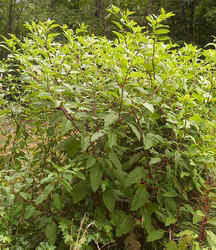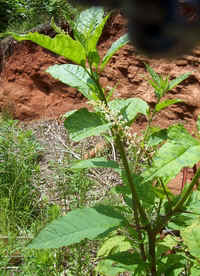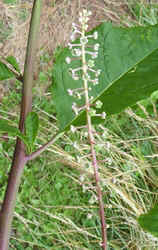 |
 |
 |
Common Name: Pokeweed, Poke, Pigeonberry, Inkberry
Scientific Name: Phytolacca americana
Family: Phytolaccaceae
Serendipity Ranch
Columbus, North Carolina
May-June, 2002
 |
 |
 |
These rank, herbaceous perennials may reach a height of 6 feet or more and have a spread to match. The plant may have racemes of small white flowers, green fruits, and the ripe fruits, as shown here, at the same time late in the season. The juice of the berries was once used for ink and the young, tender leaves are excellent when properly cooked. The root is poisonous. These plants are frequent in low grounds and recent clearings throughout the state and the eastern U.S. May-frost [Justice, William S. and Bell, C. Ritchie, Wild Flowers of North Carolina. University of North Carolina Press, Chapel Hill, 1968]
Note the coarse reddish stems of this weedy, large-leaved plant. Greenish-white sepals look like petals. Flower clusters often pairs with leaves, fruiting clusters droop; berries purple-black, with red stalks. 4-10 feet. Damp thickets, clearings, roadsides. July-September [Peterson, Roger Tory and McKenny, Margaret, Peterson Field Guides: A Field Guide to Wildflowers of Northeastern and Northcentral North America. Houghton Mifflin Company, Boston, 1968]
Pigeonberry, sometimes referred to as pokeweed or just plain poke, is an abundant, tall, large-leaved plant with reddish stems and long, arching clusters of small white flowers. Each flower is about 1/4 inch across with five white petal-like sepals. Petals are absent. The leaves are up to 10 inches long, are elliptic to lanceolate, and taper at both ends. As the plant matures, the flowers give way to small green berries, which ripen to a dark purple or black. This plant has been widely used for food and medicinal purposes. Early settlers cooked the springtime leaves and stems and ate them as greens. It was believed that pigeonberry greens revived the blood, and since it is full of vitamin C and iron, it could be quite beneficial. The root of this plant is poisonous, and after the berries ripen the entire plant becomes poisonous and should not be eaten. Indians made use of the berries for staining and dying. This might account for it often being called inkberry. It was an old custom among mountain folks to wear a string of pigeonberries to ward off contagious diseases. At one time the berry juice was even used to improve the taste of cheap wine. Pigeonberry is frequently seen in open fields and waste areas. June-frost [Alderman, J. Anthony, Wildflowers of the Blue Ridge Parkway. The University of North Carolina Press, Chapel Hill, 1997]
January February March April May June July August September October November December
Alphabetical Listings -- A B C D, E F G H I, J, K L M N, O P Q, R S T U, V W X, Y, Z
Family Listings -- A B C D, E F G H I, J, K L M N, O P Q, R S T U, V W X, Y, Z
Genus Listings -- A B C D, E F G H I, J, K L M N, O P Q, R S T U, V W X, Y, Z